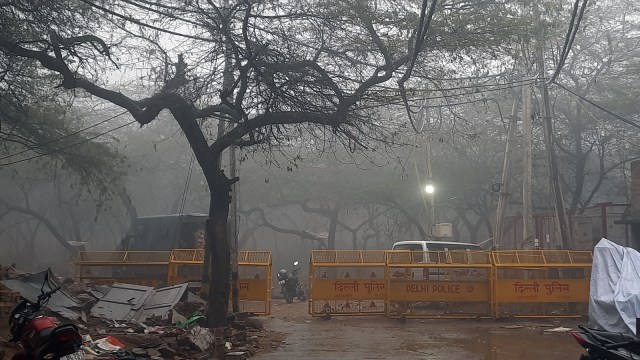Calling it illegal, DDA demolished mosque in Mehrauli; ASI records listed it a century ago
On January 30, the Delhi Development Authority (DDA) razed the Akhoondji mosque and a madrasa, describing them as “illegal structures” in Sanjay Van, a reserved forest area.
 The Akhoondji Masjid was demolished on January 30. (File Photo)
The Akhoondji Masjid was demolished on January 30. (File Photo)No one’s quite sure when the Akhoondji Masjid was built in Mehrauli. But the “Mosque of Akhondji” was listed in a 1922 publication by an officer of the Archaeological Survey of India who recorded that while its construction date was “unknown”, the mosque was repaired in “1270 AH (1853-4 AD)”, and that it lay west to to an old Idgah that “existed when Timur invaded India in 1398 AD”.
On January 30, the Delhi Development Authority (DDA) razed the Akhoondji mosque and a madrasa, describing them as “illegal structures” in Sanjay Van, a reserved forest area. “Removal of the illegal structures, religious in nature, was approved by the Religious Committee, conveyed vide Minutes of Meeting dated 27/01/2024,” the DDA said.
On January 31, the Delhi High Court sought an explanation from the DDA on the basis of which it demolished the mosque, and “whether any prior notice was given before taking the demolition action”.
The DDA was told by the High Court to reply within a week, and the next hearing is scheduled for February 12.
Historians and activists point out that the Sanjay Van was notified as a reserved forest area only in 1994, so how could the old mosque have been an encroachment.
The DDA’s own document on the Sanjay Van states, “Sanjay Van is a part of Mehrauli/South central ridge of Delhi… To protect and develop this heritage into a green belt, DDA in the 70s carved this area of 784 acres now called Sanjay Van… One can approach Sanjay Van (a notified reserve forest as per the 1994 notification under section 4 of the Indian Forest Act 1927) from Aruna Asaf Ali Marg… or from Qutub Institutional area…”
According to the ‘List of Muhammadan and Hindu Monuments, Volume III’ by Maulvi Zafar Hasan, Assistant Superintendent, Archaeological Survey of India, published in 1922, the “Mosque of Akhondji” was “some 100 yards to the west of Idgah” that “existed when Timur invaded India in 1398 AD”.
It recorded this about the mosque: “Date of building unknown, date of repair 1270 AH (1853-4 AD).”
It mentioned that on a red sandstone slab fixed over the central arch, the following words were engraved (translation):
“He is high and most powerful. (1) O Zafar! When Akhondji repaired this old mosque and cleared it, (2) He enquired of wisdom the date of repair, it said, ‘Praise be to good and religious man’. The year 1270.”
The entry went on to describe the structure:
“The mosque covered with an arched roof and entered through three arches supported on double pillars of grey local stone is 21’2” by 13’8” I.M. It is built of rubble masonry plastered. The floor of the prayer chamber together with that of the courtyard is also coated with plaster. The courtyard, which is enclosed by a wall, measures 36’9” by 20’ and is entered through a doorway on the north.”
Author Sohail Hashmi said, “It was a functioning mosque and… was in existence before Sanjay Van forest land came into existence in 1994, and that is why these buildings were not encroachments.”
Historian Rana Safvi, who has written extensively on the history of Mehrauli, in a post on X, said this on the demolition of the Akhoondji mosque: “Though the date of building is unknown, it was repaired in 1853-4. The chronogram for repair seems to have been written by Emperor Shah Zafar as in 1270 A.H./1853-4 he was the only one using the takhallus of Zafar.” She too quoted the translation of the chronogram on the red sandstone slab.
Six days after the DDA action, all that remains is the spot where the mosque once stood. Heavily barricaded.







